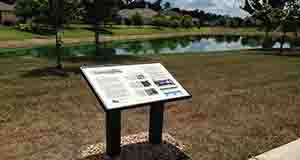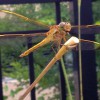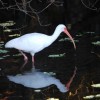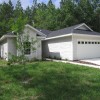
Installing educational signs is one way to increase awareness and participation in conservation activities. This six-page fact sheet written by Mark Hostetler and published by the Department of Wildlife Ecology and Conservation explains how to create educational signs and install them in residential neighborhoods as a way to inform residents about biodiversity conservation. The fact sheet, one of the UF/IFAS Conservation Subdivision series, explains how to design effective signs, how to manage a series of signs to keep the information fresh, and how to maintain the signs to ensure that residents and visitors to the community continue to benefit and maintain their homes, yards, and neighborhoods sustainably for years to come.
http://edis.ifas.ufl.edu/uw407
Tag: Conservation Subdivisions series
Conservation Subdivision: Post-construction Phase: Policy Directions and the Importance of Assessing Stakeholder Opinions
 Simply designating open space in a development is not enough to provide long-term protection for a variety of wildlife. New policies need to be developed that encourage developers of conservation developments to adopt long-term management practices that support biodiversity conservation. This 5-page fact sheet discusses policy options that could be used to support conservation management practices and reports on a survey of Colorado landowners who have created conservation developments and their opinions about a policy option to support the implementation of management practices. Written by Daniel Feinberg and Mark Hostetler, and published by the UF Department of Wildlife Ecology and Conservation, December 2014. (Photo credit: Daniel Feinberg)
Simply designating open space in a development is not enough to provide long-term protection for a variety of wildlife. New policies need to be developed that encourage developers of conservation developments to adopt long-term management practices that support biodiversity conservation. This 5-page fact sheet discusses policy options that could be used to support conservation management practices and reports on a survey of Colorado landowners who have created conservation developments and their opinions about a policy option to support the implementation of management practices. Written by Daniel Feinberg and Mark Hostetler, and published by the UF Department of Wildlife Ecology and Conservation, December 2014. (Photo credit: Daniel Feinberg)
http://edis.ifas.ufl.edu/uw401
Conservation Subdivision: Post-construction Phase–Engaging Residents (WEC334/UW379)
 As urban communities grow, design and management strategies for new developments become critical factors that determine impacts on natural resources. How can we accommodate growth yet conserve natural resources, such as biodiversity, water, and energy? In this document, we focus on conserving biodiversity when land is subdivided, constructed, and occupied. This 6-page fact sheet was written by Daniel Feinberg and Mark Hostetler, and published by the UF Department of Wildlife Ecology and Conservation, June 2013.
As urban communities grow, design and management strategies for new developments become critical factors that determine impacts on natural resources. How can we accommodate growth yet conserve natural resources, such as biodiversity, water, and energy? In this document, we focus on conserving biodiversity when land is subdivided, constructed, and occupied. This 6-page fact sheet was written by Daniel Feinberg and Mark Hostetler, and published by the UF Department of Wildlife Ecology and Conservation, June 2013.
http://edis.ifas.ufl.edu/uw379
Conservation Subdivision: Post-construction Phase – Urban Trees Can Reduce Household Carbon Footprint (WEC321/UW366)
 During the post-construction phase, the conservation and planting of native trees in individual yards and open spaces can reduce household and neighborhood carbon footprints. This 5-page fact sheet discusses the importance of urban trees and their role in mitigating for climate change by avoiding carbon emissions and removing carbon dioxide from the atmosphere. Written by Richard Vaughn, Mark Hostetler, and Francisco Escobedo, and published by the UF Department of Wildlife Ecology and Conservation, June 2012.
During the post-construction phase, the conservation and planting of native trees in individual yards and open spaces can reduce household and neighborhood carbon footprints. This 5-page fact sheet discusses the importance of urban trees and their role in mitigating for climate change by avoiding carbon emissions and removing carbon dioxide from the atmosphere. Written by Richard Vaughn, Mark Hostetler, and Francisco Escobedo, and published by the UF Department of Wildlife Ecology and Conservation, June 2012.
http://edis.ifas.ufl.edu/uw366
Conservation Subdivision: Construction Phase: Low Impact Development (LID) and Stormwater Treatment (WEC319/UW364)
 Because so much area in subdivisions is covered by impervious surfaces such as roads, buildings, and driveways, stormwater runoff must be accounted for and treated to prevent flooding and to remove contaminates. Often, stormwater runoff impacts surrounding landscapes and water bodies due to nutrient loading. In this 7-page fact sheet, we discuss the importance of using a more distributed stormwater treatment system that treats runoff closer to the source. Often called Low Impact Development (LID), this stormwater management approach is being used to more effectively remove pollutants from runoff. Written by Daniel Penniman, Mark Hostetler, and Glenn Acomb, and published by the UF Department of Wildlife Ecology and Conservation, March 2012.
Because so much area in subdivisions is covered by impervious surfaces such as roads, buildings, and driveways, stormwater runoff must be accounted for and treated to prevent flooding and to remove contaminates. Often, stormwater runoff impacts surrounding landscapes and water bodies due to nutrient loading. In this 7-page fact sheet, we discuss the importance of using a more distributed stormwater treatment system that treats runoff closer to the source. Often called Low Impact Development (LID), this stormwater management approach is being used to more effectively remove pollutants from runoff. Written by Daniel Penniman, Mark Hostetler, and Glenn Acomb, and published by the UF Department of Wildlife Ecology and Conservation, March 2012.
http://edis.ifas.ufl.edu/uw364
WEC283/UW328 Conservation Subdivision: Construction Phase – Dark-sky Lighting
WEC283, a 4-page illustrated fact sheet by Mark Hostetler, discusses how to manage lighting during the construction phase and explains the importance of good lighting to biodiversity in a conservation subdivision. Includes references. Published by the UF Department of Wildlife Ecology and Conservation, April 2010.
http://edis.ifas.ufl.edu/uw328
WEC280/UW325 Conservation Subdivision: Design Phase – Wildlife-friendly Transportation Network
WEC280, a 5-page illustrated fact sheet by Mark Hostetler and Michael Moulton, discusses road designs and placement strategies that will minimize impacts on local wildlife populations and enhance wildlife movement. Includes references. Published by the UF Department of Wildlife Ecology and Conservation, May 2010.
http://edis.ifas.ufl.edu/uw325
WEC278/UW323 Conservation Subdivision: Construction Phase – Protecting Trees and Conserved Natural Areas
WEC278, a 6-page illustrated fact sheet by Mark Hostetler and Glenn Acomb, discusses techniques and strategies that minimize impacts of the construction process on conserved trees and natural areas. Includes references. Published by the UF Department of Wildlife Conservation and Ecology, March 2010.
http://edis.ifas.ufl.edu/uw323
WEC284/UW329 Conservation Subdivision: Construction Phase – Native Landscaping Palette
WEC284, a 9-page illustrated fact sheet by Mark Hostetler and Martin B. Main, discusses the importance of emphasizing native plants when selecting a landscape palette. Includes references. Published by the UF Department of Wildlife Ecology and Conservation, May 2010.
http://edis.ifas.ufl.edu/uw284
WEC281/UW326 Conservation Subdivision: Design Phase: Wetland Considerations
WEC281, a 4-page illustrated fact sheet by Mark Hostetler, discusses issues surrounding on-site protection of wetlands and strategies to create wetlands that conserve biodiversity when land is subdivided. Includes references. Published by the UF Department of Wildlife Ecology and Conservation, March 2010.
http://edis.ifas.ufl.edu/uw326
WEC276/UW321 Conservation Subdivision: Design Phase – Location of Conserved Open Spaces
WEC276, a 5-page illustrated fact sheet by Mark Hostetler, focuses on decisions made in the design phase — what percentage of the site will be conserved as open space and where to locate it so as to maximize biodiversity values. Includes references. Published by the UF Department of Wildlife Ecology and Conservation, December 2009.
http://edis.ifas.ufl.edu/uw321
WEC275/UW320 Conservation Subdivision: Design Phase – Patch Size and Shape of Conserved Open Spaces
WEC275, a 5-page illustrated fact sheet by Mark Hostetler and Hal Knowles, III, focuses on conserving biodiversity of native species when land is subdivided. Includes references. Published by the UF Department of Wildlife Conservation and Ecology, December 2009.
http://edis.ifas.ufl.edu/uw320